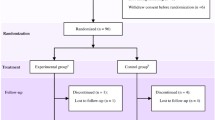Abstract
Background
To present a comprehensive experience of botulinum toxin A (BTX-A) injected into the detrusor muscle in patients with spinal cord injuries (SCI) causing neurogenic detrusor overactivity.
Methods
Three hundred units of BTX-A were injected cystoscopically into the detrusor muscle of 108 patients with neurogenic detrusor overactivity secondary to SCI at 30 different locations. Evaluations were performed before the injections and 6 weeks after, and they included determination of bladder urinary continence status, frequency/volume chart of CIC, concomitant anticholinergic medication use, Incontinence Quality of Life questionnaire (I-QOL) and patient satisfaction. Key urodynamic parameters (reflex volume, maximum detrusor pressure during voiding, detrusor compliance and maximum cystometric capacity) were analyzed at the outset and during the follow-up (6, 12 and 36 weeks) examinations.
Results
By the time of the urodynamic follow-up examinations (6, 12 and 36 weeks), the mean cystometric capacity (P < 0.05) and the mean reflex volume (P < 0.05) increased significantly, while the mean voiding pressure (P < 0.05) decreased significantly. No complications or side effects were reported. Most patients considerably reduced or even stopped taking anticholinergic drugs and were satisfied with the treatment.
Conclusions
This retrospective study indicates that BTX-A injections into the detrusor muscle to treat neurogenic detrusor overactivity secondary to SCI are safe and valuable. Significant improvement of bladder function corresponded with continence and subjective satisfaction indicated by the treated patients.



Similar content being viewed by others
References
Sekhon LH, Fehlings MG (2001) Epidemiology,demographics, and pathophysiology of acute spinal cord injury. Spine 26(24 Suppl):S2–S12
Riccabona M, Koen M, Schindler M et al (2004) Botulinum-A toxin injection into the detrusor: a safe alternative in the treatment of children with myelomeningocele with detrusor hyperreflexia. J Urol 171:845–848
Schurch B, Stohrer M, Kramer G et al (2000) Botulinum-A toxin for treating detrusor hyperreflexia in spinal cord injured patients: a new alternative to anticholinergic drugs? Preliminary results. J Urol 164:692–697
Lacy DB, Tepp W, Cohen AC et al (1998) Crystal structure of botulinum neurotoxin type A and implications for toxicity. Nat Struct Biol 5:898–902
de Paiva A, Meunier FA, Molgo J et al (1999) Functional repair of motor endplates after botulinum neurotoxin type A poisoning: biphasic switch of synaptic activity between nerve sprouts and their parent terminals. Proc Natl Acad Sci USA 96:3200–3205
Stohrer M, Schurch B, Kramer G et al (1999) Botulinum A toxin in the treatment of detrusor hyperreflexia in spinal cord injury. A new alternative to medical and surgical procedures? Neurourol Urodyn 18:401–402
Rieder CR, Schestatsky P, Socal MP et al (2007) A double-blind, randomized, crossover study of prosigne versus botox in patients with blepharospasm and hemifacial spasm. Clin Neuropharmacol 30:39–42
Quagliato EM, Carelli EF, Viana MA (2010) Prospective, randomized, double-blind study, comparing botulinum toxins type A botox and prosigne for blepharospasm and hemifacial spasm treatment. Clin Neuropharmacol 33:27–31
Maynard FM Jr, Bracken MB, Creasey G et al (1997) International standards for neurological and functional classification of spinal cord injury. American spinal injury association. Spinal Cord 35:266–274
Blaivas JG, Awad SA, Bissada N et al (2005) Urodynamic procedures: recommendations of the urodynamic society I. Procedures that should be available for routine urologic practice. Neurourol Urodyn 1:51–55
Schurch B, Denys P, Kozma CM et al (2007) Botulinum toxin A improves the quality of life of patients with neurogenic urinary incontinence. Eur Urol 52:850–858
Schulte-Baukloh H, Weiss C, Stolze T et al (2005) Botulinum-A toxin detrusor and sphincter injection in treatment of overactive bladder syndrome: objective outcome and patient satisfaction. Eur Urol 48:984–990
Reitz A, Stohrer M, Kramer G et al (2004) European experience of 200 cases treated with botulinum-A toxin injections into the detrusor muscle for urinary incontinence due to neurogenic detrusor overactivity. Eur Urol 45:510–515
Smith CP, Gangitano DA, Munoz A et al (2008) Botulinum toxin type A normalizes alterations in urothelial ATP and NO release induced by chronic spinal cord injury. Neurochem Int 52:1068–1075
Dixon J, Glosing J (1987) Structure and innervation in the human. In: Torrens M, Morrison JFB (eds) The physiology of the lower urinary tract. Springer, New York, pp 3–22
Brading A (1987) Physiology of bladder smooth muscle. In: Torrens M, Morrison JFB (eds) The physiology of the lower urinary tract. Springer, New York, pp 161–192
Akbar M, Abel R, Seyler TM et al (2007) Repeated botulinum-A toxin injections in the treatment of myelodysplastic children and patients with spinal cord injuries with neurogenic bladder dysfunction. BJU Int 100:639–645
Kuo HC (2004) Urodynamic evidence of effectiveness of botulinum A toxin injection in treatment of detrusor overactivity refractory to anticholinergic agents. Urology 63:868–872
Kuo HC (2005) Clinical effects of suburothelial injection of botulinum A toxin on patients with nonneurogenic detrusor overactivity refractory to anticholinergics. Urology 66:94–98
Schurch B, Denys P, Kozma CM et al (2007) Reliability and validity of the incontinence quality of Life questionnaire in patients with neurogenic urinary incontinence. Arch Phys Med Rehabil 88:646–652
Hori S, Patki P, Attar KH (2009) Patients’ perspective of botulinum toxin-A as a long-term treatment option for neurogenic detrusor overactivity secondary to spinal cord injury. BJU Int 104:216–220
Grosse J, Kramer G, Stohrer M (2005) Success of repeat detrusor injections of botulinum a toxin in patients with severe neurogenic detrusor overactivity and incontinence. Eur Urol 47:653–659
Schulte-Baukloh H, Knispel HH, Stolze T et al (2005) Repeated botulinum-A toxin injections in treatment of children with neurogenic detrusor overactivity. Urology 66:865–870
Dressler D, Hallett M (2006) Immunological aspects of botox, dysport and myobloc/neurobloc. Eur J Neurol 13(Suppl. 1):11–15
Herrmann J, Geth K, Mall V et al (2004) Clinical impact of antibody formation to botulinum toxin A in children. Ann Neurol 55:732–735
Acknowledgment
The source of funding for this research is China National Technology R&G Program, No. 2008BAI50B06.
Author information
Authors and Affiliations
Corresponding author
Rights and permissions
About this article
Cite this article
Chen, G., Liao, L. Injections of Botulinum Toxin A into the detrusor to treat neurogenic detrusor overactivity secondary to spinal cord injury. Int Urol Nephrol 43, 655–662 (2011). https://doi.org/10.1007/s11255-010-9873-x
Received:
Accepted:
Published:
Issue Date:
DOI: https://doi.org/10.1007/s11255-010-9873-x




